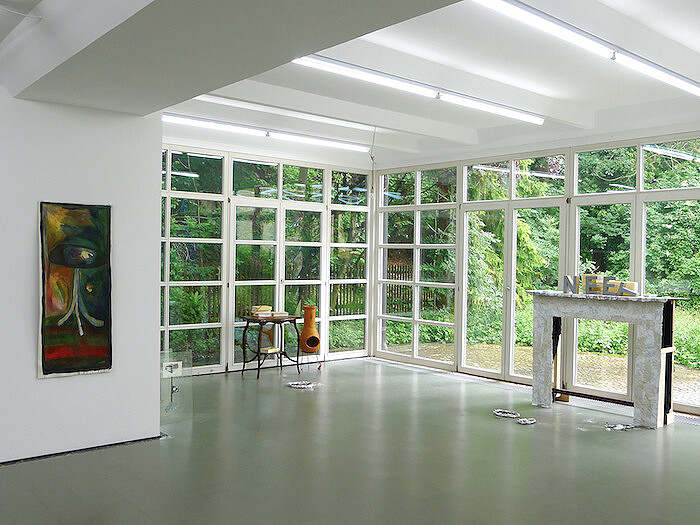Munich is a place for long shots. It lacks Berlin’s elegantly wasted charm and it is not an international youth hostel of art. Quite on the contrary, for emerging artists or for young galleries Munich is a rough patch with its incredibly high rents and living expenses. But its haute bourgeois appearance has a decidedly liberal twist. Its institutions are highly international, and some of the city’s galleries have been essential in introducing and supporting progressive and even revolutionary movements in art. Think of the group SPUR, the German branch of the Situationist International, for example, which was founded in Munich in 1958 and backed by Galerie van der Loo; or of Six Friedrich’s introduction of Andy Warhol and Minimalism; and of Rüdiger Schöttle’s role in the reception of Conceptual Art in the German context in the 60s and 70s; or of Barbara Gross’s premiering of works by Louise Bourgeois, Kiki Smith, or Nancy Spero in the 80s. All those galleries still exist in Munich today with no less reputable and rejuvenated programs. Artists here have time to develop their works—and their reputations—before exposing themselves to the permanent visibility of cities like Berlin, London, or New York.
This is what makes Munich so idiosyncratic, and a good example thereof is the recent opening of Deborah Schamoni Galerie. Schamoni—a filmmaker from Munich who lived for long spells in Hamburg and Berlin, engaging heavily in both art scenes—inaugurated her space in Oberföhring, around the corner from the Goetz Collection, this spring with a group show featuring well-established artists like Cosima von Bonin, Stephan Dillemuth, Judith Hopf, and Henrik Olesen, along with the painter and sculptor Michaela Eichwald, and L.A.-based video artist and curator Al Steiner, as well as two younger local artists, Stephan Janitzky and Max Schmidtlein. Currently the latter two share their first solo show in Schamoni’s gallery, collaboratively and intriguingly complicating their relation to painting, to Munich, and to their own situation as artists in this town of high cultural esteem.
Entitled “it’s just a way to stay alive / Zukunftswahn,” the show consists of twenty small and medium scale works: installations, photography, paintings, and sculptures. But the specificity of Janitzky’s and Schmidtlein’s individual productions (and their combined logic in this exhibition) only becomes evident when two things are taken into consideration: the location of the gallery in a neighborhood of stately mansions, close to the English Garden, and the state of denial that the city of Munich has cultivated in relation to the imminent crisis of capitalism since 2008.
Entering the largest of the show’s three rooms, it is hard to detect right away which format belongs to which artist. There are slender body-size chromatic watercolors delineating elegant but shaky nineteenth-century wooden side tables; a series of small photographic c-prints pinned to the wall by glass panels, adorned with clay twigs and thin golden chains, no less; and two installative small “painting objects.” The latter lean against the wall on purple and grey slats of wood, each bearing a white tile mounted at eye level, and supported by a pillow pedestal of sorts. Each tile displays a vaguely discernible landscape. The other object seems to be a ramshackle marble mantle lined with books and the letters N - E - E - T, with the T having toppled over. All things depicted or suggested, at least, belong to the universe of bourgeois life: the study table, the space of cultivated nature, the material smudge that has come to represent a “landscape.” Not Anselm Kiefer’s history-format displays of dried-up revenants of nature on canvas, but miniatures, made from scale modeling materials. The horizon line of the tile paintings is highly artificial and made of paint, glitter, bristles, and plastic mud: the Romantic made contemporary. The same holds true for the seven photographs featuring clay masks of a human face placed in the flamboyant vegetation of the city’s English Garden, pinned to tree branches, dug into the moss, hidden under a wadded up shirt, lost. They explicate what the whole exhibition seems to imply: that within that horizon before which this production presents itself, the sublimity of the sophisticated bourgeoisie, so characteristic of Munich, consists of its own relentless acculturation. Interiority and exteriority—all is cultivated, disciplined, scrubbed—nothing is natural, and yet, nature remains the ideal, which is reconstructed and reiterated. And the same goes for the artist’s very own artistic media, that of painting and sculpture.
But neither Janitzky’s landscape paintings nor the little puddles of silver foil on the gallery’s floors, in which the model material seems to turn back towards vegetation, moldy and formless, nor Schmidtlein’s watercolors and photographs, for that matter, seem bitter or aggressive. Janitzky’s and Schmidtlein’s theme is rather not the denunciation of a fading class, but the artist’s self-positioning on its fringes. “it’s just a way to stay alive / Zukunftswahn” offers an entrance into a young Munich art scene which very consciously deals with the wealth and the pretense of the city, embracing its own Zukunftswahn (future delusions). And if one draws nearer to the mantelpiece in the gallery and realizes that Janitzky fashioned it out of the same leaning wooden slats on which his paintings are mounted, covered only by cheap marble patterned plastic foil, this “staffage” carries the final clue to the enfolding panorama. The word N.E.E.T. is an acronym, the press release explains, that stands for “Not in Education, Employment, or Training.” It is one of the joint works in the exhibition and it spells out Janitzky’s and Schmidtlein’s status as young artists in Munich—no strings, for that matter, nor securities, attached.







